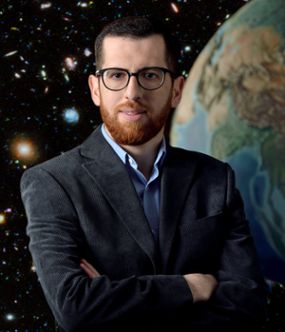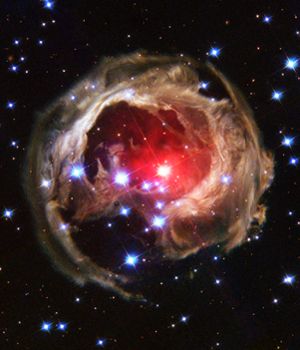MSU's Elias Aydi awarded prestigious NASA Hubble Fellowship
Hubble. A word that immediately conjures thoughts of space and stunning images of the galaxy captured during the Hubble Space Telescope’s mission to unlock the secrets of the universe.

But Hubble encompasses even more, including the NASA Hubble Fellowship Program (NHFP), which supports promising postdoctoral scientists to pursue independent research that contributes to NASA Astrophysics, using theory, observation, experimentation or instrument development.
Elias Aydi, a postdoc in Michigan State University’s Department of Physics and Astronomy in the College of Natural Science is one of a select group of 24 young scientists internationally who were awarded a prestigious 2022 NASA Hubble Fellowship.
“I am deeply humbled and honored to be awarded this prestigious fellowship,” said Aydi, “and I am very excited to continue my research at MSU as a NASA Hubble Fellow. When I saw the email starting with ‘Congratulations,’ I couldn't believe my eyes. I barely read the first line of the email and immediately called my mother back home to share with her the news about this achievement.”
The NASA Hubble Fellowship Program provides salary support plus benefits for up to three years and an additional allowance for travel and other research costs.
“I am absolutely thrilled that Elias was awarded a Hubble Fellowship and has chosen to bring it to Michigan State,” said Laura Chomiuk, associate professor in the Department of Physics and Astronomy, with whom Aydi works. “Elias brings so much to my research group—not only is he a vibrant and cutting-edge researcher, he cares deeply about making our department a better place. I love tackling research problems with Elias, but I also love watching him mentor undergrads and lead public outreach events at the MSU Observatory.”
Once selected, NASA Hubble Fellows are assigned to one of three sub-categories corresponding to NASA’s “big questions”: How Does the Universe Work? (Einstein Fellows), How Did We Get Here? (Hubble Fellows), and Are We Alone? (Sagan Fellows).
As a Hubble Fellow, Aydi plans to combine multi-wavelength observations from diverse NASA space-based facilities, several ground-based observatories, and 3D radiation-hydro simulations to decipher shocks in novae and work on solving several long-standing puzzles in high-energy astrophysics.

“In the past decade, NASA's Fermi gamma-ray satellite has established novae as a new class of high-energy gamma-ray sources, which led to a paradigm shift in our understanding of these eruptions, with implications to other cosmic explosive phenomena,” Aydi explained. “The high-energy gamma-ray emission from novae highlighted the role of strong shocks—the product of collision between ejected material during the explosion—in powering the emission in novae.”
Aydi recently led a study that combined observations from several NASA missions, which provided the first direct observational evidence that shocks could indeed power a large fraction of the luminosity of a stellar explosion, possibly surmounting the emission powered by the thermonuclear reactions.
“With currently available NASA missions, such as the Fermi-LAT Gamma-ray Satellite and the recently launched James Webb Space Telescope, along with cutting-edge ground-based observatories,” added Aydi, “it is an exciting time to be working on these explosive cosmic events and to make use of all these facilities to decipher the physical mechanisms that are taking place during nova eruptions.”
In addition to his cutting-edge research, Aydi makes time to organize outreach activities to the local community, giving approximately 12 talks a year to audiences ranging from school kids and their families to the public. He has presented at the Abrams Planetarium, the MSU Science Festival, Astronomy on Tap in Lansing, Mich., and 4-H programs across Michigan.
Aydi has also created online astronomy content in his native Arabic targeted to the public in the Middle East and North Africa (MENA). His page, which has more than 5,000 followers, is the only one in the MENA region that publishes astronomy content in Arabic.
“The Hubble Fellowship is the most prestigious postdoctoral fellowship in astronomy and astrophysics and it is wonderful to see Dr. Aydi receive this recognition for his hard work and the results that have come from it,” said Stephen Zepf, professor and chair, Department of Physics and Astronomy. “Elias has been a positive force in the physics and astronomy department in research and outreach. His award is also recognition for the department and MSU, as Elias both did the research on which his application was based here in collaboration with Professor Chomiuk and chose to stay here on this fellowship to continue his work at MSU.”
The Space Telescope Science Institute administers the NHFP on behalf of NASA, in collaboration with the NASA Exoplanet Science Institute at the California Institute of Technology and the Chandra X-ray Center at the Smithsonian Astrophysical Observatory.
Banner image: V906 Carinae (circled) shines near peak brightness in this image taken
on March 23, 2018, three days after the nova was discovered. The beautiful cloud of
gas and dust dominating the picture is part of the Carina Nebula. Credit: Chamaeleon
and Onjala Observatory